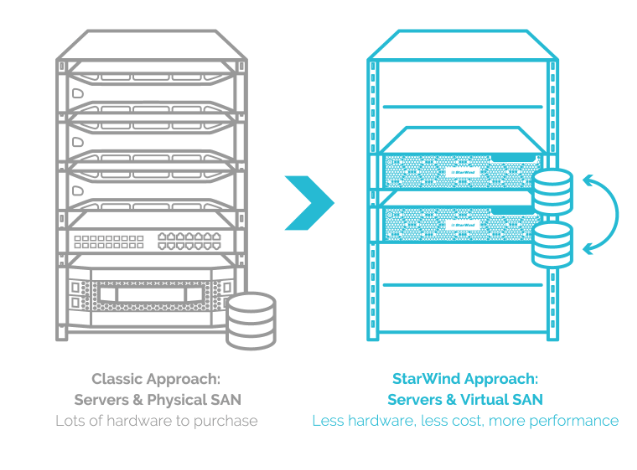Virtualized storage at enterprise level with a startup price tag?
Even the smallest business can benefit from virtualization and hyperconvergence. And the very largest organization should be able to deploy those same technologies at any required scale, without breaking the bank.
That’s the situation facing hardware and software makers today, who are aware that creating solutions for high-end data centers may well provide what the big players want, but not necessarily at justifiable price points– and certainly not at a price attractive to the smaller business.
Conversely, making solutions that are cheap to buy and simple to deploy might create an even playing field for those startup businesses facing larger rivals, but the more significant players insist on enterprise-level reliability and interoperability.
Some technology companies have tried to serve a broader range of client size by offering their products through different labels, like Cisco pushing its consumer and SME products under the Linksys brand, while leaving the enterprise to buy Cisco hardware and expertise.
But even that approach wouldn’t be suitable today for smaller organizations, who need to access data and provide services to their customers on the types of scales and with the levels of resilience that are the same as the enterprise’s. Failing to deliver in times of peak demand can spell disaster to the small startup, and it’s with these types of situations that virtualized services were designed to cope.
In massive data centers and more modest technology stacks, the elements are the same: storage, compute, and networking. Virtualized servers and convergent solutions are a waypoint on the way to the goal of providing fluid, scalable, and reliable resources to power the modern business — ensuring the delivery of services in times of peak demand (regardless of the business’s size) and allowing scalability for the future. But the issues of multiple management interfaces, specialist hardware, and the need for staff expertise all remain, and those issues make costs pile up.
But when all elements of the data infrastructure are software-defined, even a modest outfit with just a systems administrator or two can quickly and painlessly control all three elements according to the business’s dictates. In a hyperconverged infrastructure, resources can be allocated according to pre-set rules, automated timetables, or manually according to need. If there’s a burst in demand or the need for a system’s duplication for development, HCIs (hyperconverged infrastructures) can adapt in an instant, creating the resources necessary, and all from a central command-and-control interface.

Source: StarWind VSAN
Virtual machines (VMs) are pretty much standard issue in the technologist’s resource pool today, and are simple to manage, with a range of mature offerings from companies, primarily VMware (vSphere) and Microsoft (Hyper-V). Now, software-defined storage can remove the physical differences between VM clusters and SAN systems. Software-defined storage (SDS) reduces storage costs significantly because dedicated storage hardware is no longer required, storage containers are virtualized, and control is at the OS or hypervisor layer.
That fulfills both the “briefs” touched on earlier: the smaller organization benefits from lower costs (no proprietary hardware needed to fill rack space), and the enterprise gets massive scalability and malleability thanks to software abstraction of the entire storage array.
SDS is not a technology just for the enterprise: StarWind, whose HCI offerings have garnered glowing reviews (and showcased by some lovely 8-bit style graphics) have a range of VSAN products that offer a massively extensible virtualized storage platform that can start small and grow big, or— for the already-big organization— create huge storage and management savings, at scale.
Storage can be offered in highly fault-tolerant lakes to all VM clusters because the VSAN itself comprises of two (or two hundred) VM instances. That makes managing the VSAN as familiar as managing any virtual server, so the system administrator gets another arrow in their quiver without lifting a finger!
As a virtualized service, StarWind VSAN is available for AWS and Azure, and runs in Hyper-V or vSphere environments. For those cloud providers, the solution is dropped in through those vendors’ respective marketplaces.
For Hyper-V users (a platform generally considered to be in greater use, though not exclusively, in the SME sector), StarWind’s VSAN just installs in the parent partition. Pricing is according to numbers of nodes, and therefore won’t present any unpleasant surprises down the line. Storage virtualization can start small, from one node and 4GB capacity, but then scale out so every business size can have virtualized storage that’s scalable, of enterprise-level resilience, and that can be managed right from inside the standard Windows Server management toolset.
Naturally enough, IT managers are (quite rightly) a conservative bunch, so no-one is expected to dive right into a new solution without a solid proof-of-concept and rigorous testing. StarWind are aware of this need, so that’s available with VSAN FREE. The FREE tier is fully-production ready but explicitly designed with POC, testing and development in mind.
Making the monetary investment, however, means every business gets StarWind’s legendary support and help service. In real-world settings, the expert at the end of the phone line, 24/7, proves invaluable to systems administrators all over the world.
Check back here in a month to read in more depth about StarWind’s VSAN for vSphere offerings. Those too represent fantastic value-for-money over traditional SAN arrays, something that administrators of the more expensive vSphere platform will be interested in. Like all StarWind’s VSAN offerings, in vSphere topologies, VSAN is managed simply and easily without needing to employ a specialist storage team.









